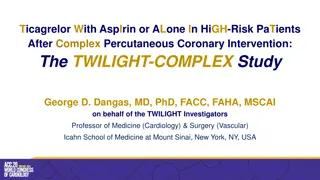Pharmacodynamic Effects of Switching from Ticagrelor to Clopidogrel in Patients with Coronary Artery Disease: SWAP-4 Study
Pharmacodynamic effects of switching P2Y12 inhibitors from ticagrelor to clopidogrel in coronary artery disease patients were investigated in the SWAP-4 study. De-escalation between these agents is common for various reasons. The study assessed the impact of clopidogrel loading dose, maintenance dose, and timing of administration on platelet reactivity. Pharmacodynamic assessments were based on P2Y12 reaction units, platelet reactivity index, and maximal platelet aggregation. The study provided insights into drug-drug interactions and optimal strategies for switching antiplatelet therapy.
Download Presentation

Please find below an Image/Link to download the presentation.
The content on the website is provided AS IS for your information and personal use only. It may not be sold, licensed, or shared on other websites without obtaining consent from the author.If you encounter any issues during the download, it is possible that the publisher has removed the file from their server.
You are allowed to download the files provided on this website for personal or commercial use, subject to the condition that they are used lawfully. All files are the property of their respective owners.
The content on the website is provided AS IS for your information and personal use only. It may not be sold, licensed, or shared on other websites without obtaining consent from the author.
E N D
Presentation Transcript
Francesco Franchi, MD, Fabiana Rollini, MD, Jose Rivas Rios, MD, Andrea Rivas, MD, Malhar Agarwal, MD, Megha Kureti, MD, Deepa Nagaraju, MD, Mustafa Wali, MD, Zubair Shaikh, MD, Maryuri Briceno, MD, Ahmed Nawaz, MD, Jae Youn Moon, MD, PhD, Latonya Been, AAS, Siva Suryadevara, MD, Daniel Soffer, MD, Martin M Zenni, MD, Theodore A Bass, MD, Dominick J Angiolillo, MD, PhD Franchi F, et al. Circulation, 2018 DOI: 10.1161/CIRCULATIONAHA.118.033983
Pharmacodynamic Effects of Switching from Ticagrelor to Clopidogrel in Patients with Coronary Artery Disease: Results of the SWAP -4 Study Background Switching between different classes of P2Y12 inhibitors commonly occurs in clinical practice. This includes de-escalation (i.e., switching from a more potent to a less potent agent). Reasons to de-escalate include costs, side effects, and variations in ischemic and bleeding risk patterns over time. Phamacodynamic investigations have suggested the potential for drug-drug interactions particularly when switching between different classes of P2Y12 inhibitors. Despite the superiority of ticagrelor over clopidogrel in reducing ischemic events, many physicians often limit treatment duration with ticagrelor to just the early months or even weeks following an ACS. The pharmacodynamic effects and the optimal approach of switching from ticagrelor to clopidogrel remain poorly explored Franchi F, et al. Circulation, 2018
Pharmacodynamic Effects of Switching from Ticagrelor to Clopidogrel in Patients with Coronary Artery Disease: Results of the SWAP -4 Study Study design SWAP-4 was a prospective, randomized, open-label, single center study aimed to assess the pharmacodynamic effects of de-escalating from ticagrelor to clopidogrel in patients with CAD on a background of aspirin therapy, and how this is affected by the use of a clopidogrel LD compared with a MD regimen and the impact of different timing of LD administration Franchi F, et al. Circulation, 2018
Pharmacodynamic Effects of Switching from Ticagrelor to Clopidogrel in Patients with Coronary Artery Disease: Results of the SWAP -4 Study Methods Pharmacodynamic assessments were performed using P2Y12 reaction units (PRU) by VerifyNow, platelet reactivity index (PRI) by VASP and maximal platelet aggregation (MPA) by LTA Genetic testing was performed in all patients to define the impact of CYP2C19 genetic status using the Spartan RX rapid genotyping device The primary endpoint was the comparison of PRU at 48 hours after switching between clopidogrel 600 mg LD administered 24 hours after the last ticagrelor MD and clopidogrel 75 mg MD given 24 hours after the last ticagrelor MD Under the assumption of a mean difference of 60 PRU between groups, a common standard deviation of 50 PRU, and a possibility of having invalid data in 20-25% of patients due to technical issues or drop-outs a sample size of 80 patients was required with a 95% power and alpha=0.05. Drug-drug interaction was defined as the presence of levels of platelet reactivity after de- escalation significantly higher than those at baseline while on maintenance clopidogrel Franchi F, et al. Circulation, 2018
Pharmacodynamic Effects of Switching from Ticagrelor to Clopidogrel in Patients with Coronary Artery Disease: Results of the SWAP -4 Study Statistical Analysis An ANCOVA method with a general linear model, using the baseline value of platelet reactivity as covariate, was used to evaluate the primary end point as well as all between- groups comparisons at each single time point. A mixed between-within subjects ANCOVA with polynomial contrast, also adjusted for baseline platelet reactivity, was conducted with a general linear model to evaluate the overall difference between groups across time points. A repeated measures ANOVA model was used to evaluate intra-group comparisons. This model was used to estimate the difference ( ) in platelet reactivity between each time point and baseline (while patients were on maintenance clopidogrel therapy), in order to investigate the presence of a drug-drug interaction. Chi-square test was used to compare rates of HPR among groups. An interaction analysis to assess the effects of LOF status on the main effect of treatment group was performed through a general linear model. Franchi F, et al. Circulation, 2018
Pharmacodynamic Effects of Switching from Ticagrelor to Clopidogrel in Patients with Coronary Artery Disease: Results of the SWAP -4 Study Results PRU levels were similar between C-600mg-24h and C-75mg-24h (p=0.29), including at 48 hours (primary endpoint; LSM difference: -6.9; 95% CI: -38.1 to 24.3; p=0.66). PRU levels were lower with C-600mg-12h versus C-75mg-24h (p=0.024) VerifyNow P2Y12 Franchi F, et al. Circulation, 2018
Pharmacodynamic Effects of Switching from Ticagrelor to Clopidogrel in Patients with Coronary Artery Disease: Results of the SWAP -4 Study Results MPA over time was lower with both C-600mg-24h (p=0.041) and C-600mg-12h (p=0.028) compared with C-75mg-24h (Figure 3). PRI profiles paralleled those observed with PRU. There were no PD differences for all tests between C-600mg-24h and C-600mg-12h. LTA VASP Franchi F, et al. Circulation, 2018
Pharmacodynamic Effects of Switching from Ticagrelor to Clopidogrel in Patients with Coronary Artery Disease: Results of the SWAP -4 Study PRU MPA PRI Franchi F, et al. Circulation, 2018
Pharmacodynamic Effects of Switching from Ticagrelor to Clopidogrel in Patients with Coronary Artery Disease: Results of the SWAP -4 Study High on-treatment platelet reactivity Franchi F, et al. Circulation, 2018
Pharmacodynamic Effects of Switching from Ticagrelor to Clopidogrel in Patients with Coronary Artery Disease: Results of the SWAP -4 Study Summary of Study Findings 1) Switching from ticagrelor to clopidogrel using a LD (prior to starting MD) was associated with greater levels of platelet inhibition during the first 48 hours compared with switching directly to a MD regimen (without a LD) 2) The PD profiles did not differ according to timing of administration of the LD (12 vs 24 hours following ticagrelor discontinuation) 3) The PD profiles of switching from ticagrelor to clopidogrel were suggestive of a drug- drug interaction, which was mitigated with the administration of a LD (irrespective of timing of administration) 4) De-escalation was also associated with an increase in HPR with time after randomization, although the proportion of patients with HPR did not exceed baseline levels 5) CYP2C19 genetic status did not appear to have any meaningful impact on the study findings. Franchi F, et al. Circulation, 2018
Pharmacodynamic Effects of Switching from Ticagrelor to Clopidogrel in Patients with Coronary Artery Disease: Results of the SWAP -4 Study Conclusions De-escalation from ticagrelor to clopidogrel therapy is associated with an increase in platelet reactivity suggestive of a drug-drug interaction. Administration of a LD prior to initiating a MD regimen of clopidogrel mitigates these observations by delaying and hampering the increase in platelet reactivity. Delaying timing of LD administration following ticagrelor discontinuation did not improve the PD profile of such de-escalation strategy. Larger studies are warranted to assess the safety and efficacy of de-escalation strategies. Franchi F, et al. Circulation, 2018























